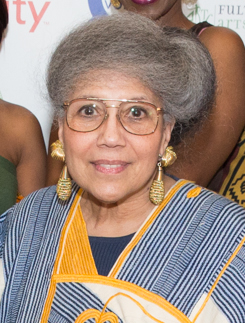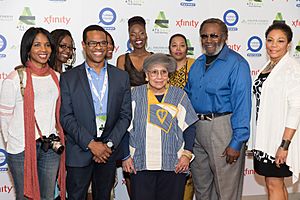Doris Derby facts for kids
Quick facts for kids
Doris Derby
|
|
|---|---|

Derby in 2014
|
|
| Born | November 11, 1939 The Bronx, New York City, U.S.
|
| Died | March 28, 2022 (aged 82) Atlanta, Georgia, U.S.
|
| Occupation | Activist, photographer, educator |
| Known for | Civil rights photography |
| Spouse(s) |
Robert A. Banks
(m. 1995) |
Doris Adelaide Derby (November 11, 1939 – March 28, 2022) was an American activist, documentary photographer, and educator. She was very active in the Civil Rights Movement in Mississippi. Her work often explored themes of race and African-American identity.
Doris Derby was a working member of the Student Nonviolent Coordinating Committee (SNCC). She also helped start the Free Southern Theater. Later, she became the first director of the Office of African-American Student Services and Programs at Georgia State University. Her amazing photographs have been shown all over the world. She also wrote an essay about her experiences in the Civil Rights Movement.
Contents
Growing Up and Early Activism
Doris Derby was born on November 11, 1939, in The Bronx, New York City. Her parents, Hubert and Lucille, encouraged her from a young age. Her grandmother, Edith Delaney Johnson, even started a chapter of the NAACP in the 1920s.
When Doris was in elementary school, she noticed something important. There were not many Black people shown in her textbooks, movies, or art. This made her want to make a difference in the world.
She also loved to dance. She studied African-centered dance traditions. She even received a scholarship to take classes at the Harlem YMCA.
At age 16, Doris joined the NAACP Youth Chapter at her church. This was her first step into the Civil Rights Movement. Later, while attending Hunter College in New York, she joined the Student Nonviolent Coordinating Committee (SNCC). She discussed important topics like segregation and the Freedom Riders. As a student activist, she was on the front lines of the movement. She worked with SNCC in New York, Albany, Georgia, and throughout Mississippi.
Fighting for Civil Rights in Mississippi
In 1960, Doris traveled to countries like Nigeria, France, and Italy. She learned to appreciate different cultures. She also visited the Navajo Indian Reservation. There, she saw how much economic unfairness people faced.
In 1963, Doris was an elementary school teacher. She was asked to join an adult education program in Mississippi. This program was started by SNCC at Tougaloo College. She helped create materials to teach Black people to read. This was important because Mississippi had unfair tests to stop Black people from voting.
Doris felt strongly that she needed to work in the South. She saw a great need for change there. People from all backgrounds came together to fight for a better cause. Black people were most affected by the unfairness in the South. They took a strong stand for their rights.
Starting the Free Southern Theater
Doris Derby made many important contributions in Mississippi. She worked with other SNCC members like John O'Neal and Gilbert Moses. Together, they started the Free Southern Theater (FST).
Doris believed that a theater group could travel around the state. It could use all kinds of art to share cultural ideas. This theater would be a place for people in the movement to connect. It would also reach everyday people who had suffered the most. The theater was a way to share information and find new ways to fight segregation. Doris said, "We needed to look into ourselves to empower ourselves." This would help them reclaim the freedom they did not have in Mississippi.
The theater helped Black people think critically and create for themselves. It allowed them to explore issues of segregation and injustice. It helped spark social change and equal opportunities for everyone.
Continued Activism
From 1963 to 1972, Doris Derby was a SNCC field secretary in Jackson, Mississippi. She worked with several important groups. These included the Council of Federated Organizations (COFO) and the Mississippi Freedom Democratic Party (MFDP). She also worked with the Poor Peoples' Corporation (PPC) and the Child Development Group of Mississippi (CDGM) Head Start Program.
During this time, she helped prepare for Freedom Summer. She taught in different education programs. She also promoted local arts and culture. She helped with marketing and training for these groups.
In 1967, she joined Southern Media, Inc. This group documented the lives and struggles of people in the movement. They used photography and filmmaking. Doris also gave talks and showed her work at Jackson State College. Her book, Poetagraphy, shares her experiences during these years.
Education and Later Career
Doris Derby left Mississippi in 1972. She then focused on African and African-American studies. She earned a master's degree and a Ph.D. in social anthropology. She studied at the University of Illinois at Urbana-Champaign.
In 1990, she joined Georgia State University (G.S.U.). She became an adjunct associate professor of anthropology. She also became the founding director of the Office of African-American Student Services and Programs. Her department helped many African-American students graduate. It also strengthened cultural ties between students and the community. She also helped start the Performing and Visual Arts Council (P.V.A.C.) at Georgia State University in 2008.
Doris Derby retired from Georgia State University in 2012 after 22 years. She also taught at other colleges, including the College of Charleston.
Capturing History Through Photography
Doris Derby's father taught her how to use a camera. When she arrived in Mississippi in 1963, she began taking pictures. She wanted to document the daily efforts of people during the Civil Rights Movement.
She later explained why photography was so important to her. "I knew that we did not have our history in history books," she said. "I wanted to make sure that I recorded whatever was historical and happening around me."
Doris Derby's photographs have been shown in many places. These include the Smithsonian Institution and the Field Museum of Natural History in Chicago. Her work has also been displayed at the High Museum of Art in Atlanta. In 2009, her photos were part of an exhibit called "Road to Freedom." This exhibit explored how photography helped the Civil Rights Movement.
Her work can also be found in several books about the Civil Rights Movement and Black photographers. In 2020, her photos were part of an exhibition in London. In 2021, a collection of her images from the South was published in a book called A Civil Rights Journey.
Personal Life
Doris Derby lived in Atlanta, Georgia, with her husband, Bob Banks. They married in 1995. They were active leaders in their community. Doris Derby passed away on March 28, 2022, in Atlanta. She was 82 years old.
Awards and Recognition
Doris Derby received many honors for her work. For the 50th anniversary of the 1963 March on Washington for Jobs and Freedom, she was interviewed for a documentary. She was also featured in a special program on WSB-TV in Atlanta.
In 2010, Doris and other SNCC members celebrated the 50th Anniversary of SNCC. She is one of 52 women who contributed to the book Hands on the Freedom Plow. This book shares personal stories of women in SNCC.
In 2011, Doris Derby received the 26th Governor's Award in the Humanities in Atlanta. She was honored for documenting and saving images and stories. Her work helps current and future generations learn about the Civil Rights Movement.


